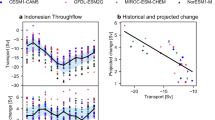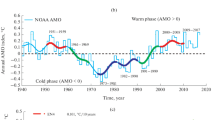Abstract
The time mean response of the summer monsoon circulation, as simulated by the 2.5° latitude-longitude resolution, July version of the National Center for Atmospheric Research (NCAR) General Circulation Model (GCM), to a variety of Indian Ocean surface temperature anomaly patterns is examined. In separate experiments, prescribed changes in surface temperature are imposed in the Western Arabian Sea, the Eastern Arbian Sea or the Central Indian Ocean. The influence of these anomaly patterns on the simulated summer monsoon circulation is evaluated in terms of the geographical distribution of the prescribed change response for any field of interest. This response is defined as the grid point difference between a 30-day mean from a prescribed change experiment and the ensemble average of the 30-day means from the control population for which the same set of climatological ocean surface temperatures are used in each simulation. The statistical significance of such a prescribed change response is estimated by relating the normalized response (defined as the ratio of the prescribed change response to the standard deviation of 30-day means as estimated from the finite sample of control cases) to the classical Student'st-statistic. Using this methodology, the most prominent and statistically significant features of the model's response are increased vertical velocity and precipitation over warm anomalies and typically decreased vertical velocity and precipitation in some preferred region adjacent to the prescribed change region. In the case of cold anomalies, these changes are of opposite sign. However, none of the imposed anomaly patterns produces substantial or statistically significant precipitation changes over large areas of the Indian sub-continent. The only evidence of a major nonlocal effect is found in the experiment with a large positive anomaly (+3°C) in the Central Indian Ocean. In this instance, vertical velocity and precipitation are reduced over Malaysia and a large area of the Equatorial Western Pacific Ocean. Thus, while these anomaly experiments produce only a local response (for the most part), it is hoped, as one of the purposes of the planned Monsoon Experiment (MONEX), that the necessary data will be provided to produce detailed empirical evidence on the extent to which Indian Ocean surface temperature anomalies correlate with precipitation anomalies over the Indian subcontinent—a correlation which generally does not appear in these GCM results.
Similar content being viewed by others
References
Chervin, R. M., Gates, W. L. andSchneider, S. H. (1974),The effect of time averaging on the noise level of climatological statistics generated by atmospheric general circulation models, J. Atmos. Sci.31, 2216–2219.
Chervin, R. M. andSchneider, S. H. (1976a),A study of the response of NCAR GCM climatological statistics to random perturbations: Estimating noise levels, J. Atmos. Sci.33, 391–404.
Chervin, R. M. andSchneider, S. H. (1976b),On determining the statistical significance of climate experiments with general circulation models, J. Atmos. Sci.33, 405–412.
Chervin, R. M., Washington, W. M. andSchneider, S. H. (1976),Testing the statistical significance of the response of the NCAR General Circulation Model to North Pacific Ocean surface temperature anomalies, J. Atmos. Sci.33, 413–423.
Findlater, J. (1971),Mean monthly airflow at low levels over the western Indian Ocean, Meteor. Office Geophys. Mem., No. 155, 53 pp.
Hahn, D. G. andManabe, S. (1975),The role of mountains in the south Asian monsoon circulation, J. Atmos. Sci.32, 1515–1541.
Joint Organizing Committee of Garp (1976),The monsoon experiment, GARP Publication Series No. 18, GARP WMO/ICSU Joint Organizing Committee, October, 1976, 123 pp.
Joseph, J. H. (1976),The effect of desert aerosol on a model of the general circulation, Paper presented at the IUGG Symposium on Radiation of the Atmosphere, Garmisch-Partenkirchen, 19–28 Aug. 1976, Federal Republic of Germany (to be published).
Krishnamurti, T. N. andMoxim, W. J. (1971),On parameterization of convective and nonconvective latent heat release, J. Appl. Meteor.10, 3–13.
Kutzbach, J. E., Chervin, R. M. andHoughton, D. D. (1977),Response of the NCAR general circulation model to prescribed changes in ocean surface temperature. Pari I: Mid-latitude changes, J. Atmos. Sci. in press.
Llewellyn, R. A. andWashington, W. M. (1977), Regional and global aspects. InEnergy and Climate, Studies in Geophysics, National Academy of Sciences Report, Washington, D. C., in press.
Manabe, S., Hahn, D. G. andHolloway, J. L. Jr. (1974),The seasonal variation of the tropical cir culation as simulated by a global model of the atmosphere, J. Atmos. Sci.33, 43–83.
Ramage, C., Miller, F. R. andJefferies, C. (1972),Meteorological Atlas of the International Indian Ocean Expedition, Vol. 1, National Science Foundation, Washington, D. C. (Superintendent of Documents, Washington, D. C., Stock No. 3800-00123).
Ramage, C. andRaman, C. R. V. (1972),Meteorological Atlas of the International Indian Ocean Expedition, Vol. 2, National Science Foundation, Washington, D.C. (Superintendent of Documents, Washington, D.C., Stock No. 3800-00124).
Raman, C. R. V. (1965),Cyclonic vortices on either side of the equator and their implications, Proceedings of Symposium on Meteorology, Results of IIOE, Bombay, 11 pp.
Rao, Y. P. andRaghavendra, V. K. (1967),Variation of pressure, wind, cloudiness and rainfall, across equator in the Indian Ocean, Proceedings of Symposium on Indian Ocean, March 1967, New Delhi, Part II, 1011–1014.
Saha, K. R. (1970),Zonal anomaly of the sea surface temperature in equatorial Indian Ocean and its possible effect on monsoon circulation, Tellus22, 403–409.
Shukla, J. (1975),Effect of Arabian sea-surface temperature anomaly on Indian summer monsoon: A numerical experiment with the GFDL model, J. Atmos. Sci.32, 503–511.
Shukla, J. (1976),Reply, J. Atmos. Sci.33, 2253–2255.
Shukla, J. andMisra, B. M. (1977),Relationships between sea-surface temperature and wind speed over the Arabian Sea, and Monsoon Rainfall over India, Mon. Wea. Rev., in press.
Sikka, D. R. andRaghavan, K. (1976),Comments on ‘Effects of Arabian sea-surface temperature anomaly on Indian summer monsoon: A numerical experiment with the GFDL model, J. Atmos, Sci.33, 2252–2253.
Smirnov, N. V. (Ed.),Tables for the Distribution and Density Functions of ‘t’-distribution (English translation) (Pergamon Press, New York 1961), 129 pp.
Srinivasan, V. (1968),Some aspects of broad-scale cloud distribution over Indian Ocean during Indian southwest monsoon season, Indian J. Meteor. Geophys.19, 39–53.
Washington, W. M. andThiel, L. G. (1970),Digitized global monthly mean ocean surface temperatures, Technical Note No. 54, National Center for Atmospheric Research, Boulder, Colorado, 94 pp.
Washington, W. M. andDaggupaty, S. M. (1975),Numerical simulation with the NCAR global circulation model of the mean conditions during the Asian-African summer monsoon, Mon. Wea. Rev.103, 105–114.
Washington, W. M. andWilliamson, D. L. (1977),A description of the NCAR global circulation models, inMethods in Computational Physics, Vol. 17, General circulation models of the atmosphere, in press.
Author information
Authors and Affiliations
Additional information
The National Center for Atmospheric Research is sponsored by the National Science Foundation
Rights and permissions
About this article
Cite this article
Washington, W.M., Chervin, R.M. & Rao, G.V. Effects of a variety of Indian Ocean surface temperature anomaly patterns on the summer monsoon circulation: Experiments with the NCAR general circulation model. PAGEOPH 115, 1335–1356 (1977). https://doi.org/10.1007/BF00874412
Received:
Issue Date:
DOI: https://doi.org/10.1007/BF00874412




